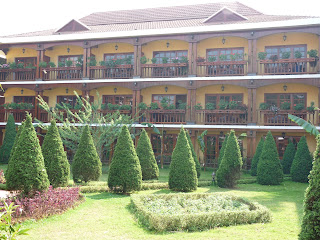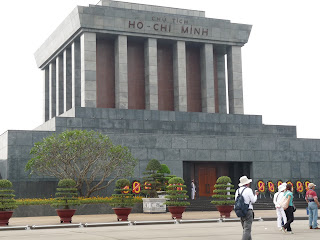






We arrived at the station in Lao Cai at around 6 am and had 1 1/2 hour drive to Sapa. Sapa is Northwest market town located about 10km South of the China border. It is a town surrounded by the Tonkines Alps with Mt. Fansipan, the highest mountain in Southeast Asia within walking distance. This market town relies heavily on its own rice paddies and terraces to feed its people, mostly made up of the hill tribes who live in Sapa.
In the early 1900's Sapa was a holiday spot for the French colonists. In the 1950's it was retaken by the Vietnamese and then bombed by the French during the War. Unique to Sapa are its hill tribes which are considered by the Vietnamese "ethnic minorities" Some tribes have lived here for thousands of years while others have arrived within the last 50 years. The tribes have immigrated from Tibet, Burma, Laos and China. During the Vietnam War, the Americans and Vietnamese fought to have the hill tribes as their allies.
Our hotel was the Victoria Hotel set upon the hill in the town. The hotel was beautiful with lush greenery and lodge type rooms. The resort overlooked the town with the mountains in the background.
As we started our walking tour to visit Cat Cat (waterfall in French), we were joined by about 6 women from the Black H'mong Tribe. Dressed in indigo-dyed clothing, silver hoop earrings and a multitude of bracelets and necklaces, these women followed us for about 2-3 hours in a walk to and through their village in hopes of us purchasing their handmade goods. They spoke fairly good English. The women in the H'mong tribe work hard - 1 day making their goods, 1 day selling and 1 day farming and then they repeat the cycle. Women are generally married at 15 or 16 and have children. There are many traditions they follow. They are persistent in selling their goods. One woman walked the entire trek with her 2 years old strapped to her back. Their living conditions are very basic and they depend on the rice harvest to keep them fed throughout the year. A common conversation with a hill tribe woman would be "you - me - we friends. You buy from me? You buy from me later, right?" You had no problem with buying from them as they befriended you, the only problem being that 3 women befriended Jim and 3 me and they all want you to buy similar good!! They got quite upset when you bought from another! We attended a concert where the young adults where putting on a dance performance. Allison and Kristin were invited up on stage to dance with them , it was very fun and exciting for all of us! We saw the waterfall for which Cat Cat is named. There were water buffalo, pigs and chickens randomly wandering around the entire valley. The water buffalo presumably know where "home" is so no one has issue with taking anyone else's water buffalo which is essential in harvesting the land. The rice paddies and terraces are everywhere you look - it is amazing. The government of Vietnam allots families in the hill tribes parcels of land free of charge to harvest and maintain. Each family has a plot of land that once harvested should provide enough rice to get them through the year. They also eat corn, which hangs from the rafters of their homes and meat from the local markets.
As we started our walking tour to visit Cat Cat (waterfall in French), we were joined by about 6 women from the Black H'mong Tribe. Dressed in indigo-dyed clothing, silver hoop earrings and a multitude of bracelets and necklaces, these women followed us for about 2-3 hours in a walk to and through their village in hopes of us purchasing their handmade goods. They spoke fairly good English. The women in the H'mong tribe work hard - 1 day making their goods, 1 day selling and 1 day farming and then they repeat the cycle. Women are generally married at 15 or 16 and have children. There are many traditions they follow. They are persistent in selling their goods. One woman walked the entire trek with her 2 years old strapped to her back. Their living conditions are very basic and they depend on the rice harvest to keep them fed throughout the year. A common conversation with a hill tribe woman would be "you - me - we friends. You buy from me? You buy from me later, right?" You had no problem with buying from them as they befriended you, the only problem being that 3 women befriended Jim and 3 me and they all want you to buy similar good!! They got quite upset when you bought from another! We attended a concert where the young adults where putting on a dance performance. Allison and Kristin were invited up on stage to dance with them , it was very fun and exciting for all of us! We saw the waterfall for which Cat Cat is named. There were water buffalo, pigs and chickens randomly wandering around the entire valley. The water buffalo presumably know where "home" is so no one has issue with taking anyone else's water buffalo which is essential in harvesting the land. The rice paddies and terraces are everywhere you look - it is amazing. The government of Vietnam allots families in the hill tribes parcels of land free of charge to harvest and maintain. Each family has a plot of land that once harvested should provide enough rice to get them through the year. They also eat corn, which hangs from the rafters of their homes and meat from the local markets.
We had the opportunity to see a performance given by the local teenagers who were playing music on native instruments and dancing with the music. Both boys and girls were dancing and telling stories through their dance. They invited Allison and Kristin up to dance as they pounded long bamboo sticks to a beat across the stage. They then dance between the bamboo. The girls did great and both the girls and the performers enjoyed the interaction. As we continued through the valley we saw local homes, men plowing the rice fields and the corn being made into grain. What amazed us the most was how ancient their farming techniques were and no one had given them instruction on how to modernize. Everything they do requires human driven labor, not machine.
We went back after a long day of hiking and rested for awhile as we were quite tired from the train ride the night before. Kristin was not feeling great but we all headed out to dinner. At the start of dinner, Kristin needed to go back to the room to sleep, she was exhausted. Sapa is a small town, but a hilly one so I wasn't sure she would make it back on foot. Our tour guide, Nam, who was eating with us, hailed a motorcycle taxi and off Kristin and I went. The driver, Kristin and I on a motorbike up to the hotel - it was quite an adventure and actually was fun! Kristin initially was a bit nervous but was all excited once we got going! We were all ready for a great night of sleep in cool weather and to rest for the next day's hike.








